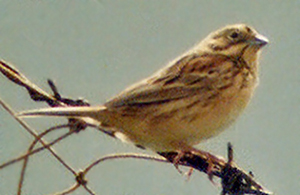Yellowhammer Emberiza citrinella

One, age unknown (possibly first year male), October 18, 2000, Gageo Island, Jeollanam Province. One or two further sightings (one by Park Jin-Young in early autumn 2002, and a second by Nial Moores on October 7th 2002, both on Gageo Island).
October 17th and 18th 2000 produced very high counts of buntings on Gageo island, with for example 700 Black-faced Buntings Emberiza spodocephala on 17th and 415 on 18th, and 275 Chestnut Buntings Emberiza rutila on 17th increasing to 380 on 18th. Descending the very steep road down towards the Hang Ri headland in bright sunlight with a moderate to strong westerly wind, a small group of buntings flew up. One, similar in size to a Pine Bunting Emberiza leucocephalos which had been present in the same area the day before, called "plit" and landed on a wire fence, at about 40 m range. Although large like Pine Bunting, this individual was clearly yellow on the underparts and showed extensive rufous on the upperparts, especially the rump but also on the scapulars. Considering the possibility that it was a Yellowhammer (a species seen many times in the UK, where it is common) Nial Moores immediately started taking a series of photographs with a hand-held camera through his telescope. After about 10 seconds, the bunting dropped out of view, and although searched for intensively could not be found again.
Although views were brief, the description taken at the time and the series of photographs reveal clearly that it was indeed a Yellowhammer, of the eastern subspecies erythogenys. (1) The upperparts were brownish (lacking the olive tones of western birds), marked with heavy blackish streaking, and (2) warm brown or rufous scapulars. (3) The rump was strongly rufous, and (4) the tail darkerbrown, with white outer tail feathers. (6) The closed wing showed two weak yellow wing-bars, and (7) remiges that showed clear yellowish edges (a diagnostic feature of Yellowhammer). The head was well-marked, but less so than many Yellow-breasted Bunting Emberiza aurola, with (8) a weak yellowish central crown stripe, dark lateral crown stripes, and a broad yellow supercilium. The eye-stripe was dark brown, the ear coverts brown, with (9) an extensive yellow spot to the rear, and a (10) strongly defined moustachial stripe, (11) a broad yellow submoustachial stripe and (12) a well-defined malar stripe, broadening to the sides of the (13) almost unmarked yellow throat. This malar stripe appeared much more strongly marked than that found in western Yellowhammers. (14) The underparts were yellow, with a (15) faint orangey wash on the breast sides, and fine black streaking running across the breast to form a necklace and along the flanks. (16) The bill was large and grey, the upper mandible slightly darker looking than the lower, and the legs were pink.
The second individual recorded by Nial Moores, on October 7th 2002, was also found on a day with good numbers of buntings present, and very strong diurnal movements. Although seen for only ca 20 seconds in 1-Gu at about 30 m range, it appeared remarkably similar to the bird seen and photographed in 2000.
The Yellowhammer’s breeding range extends east to Lake Baikal, with some resident, and others migrating southwestward. Some also regularly winter in the Transbaikal region (Byers, Olsson and Curson, 1995). It is a rare vagrant to Japan, with five records given in Brazil (1991) and at least two further records in the 1990s, and it has also been recorded in Beijing, and Heilongjiang in the far northeast of China.



